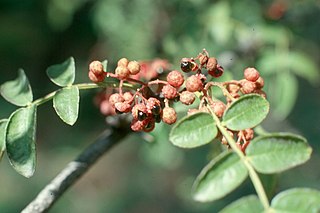
Ergoline is a chemical compound whose structural skeleton is contained in a variety of alkaloids, referred to as ergoline derivatives or ergoline alkaloids. Ergoline alkaloids, one being ergine, were initially characterized in ergot. Some of these are implicated in the condition ergotism, which can take a convulsive form or a gangrenous form. Even so, many ergoline alkaloids have been found to be clinically useful. Annual world production of ergot alkaloids has been estimated at 5,000–8,000 kg of all ergopeptines and 10,000–15,000 kg of lysergic acid, used primarily in the manufacture of semi-synthetic derivatives.

Yohimbine, also known as quebrachine, is an indole alkaloid derived from the bark of the African tree Pausinystalia johimbe; also from the bark of the unrelated South American tree Aspidosperma quebracho-blanco. Yohimbine is an α2-adrenergic receptor antagonist, and has been used in a variety of research projects. It is a veterinary drug used to reverse sedation in dogs and deer.

Heimia is a genus of flowering plants in the loosestrife family, Lythraceae. It contains two or three species of closely related shrubs commonly known as sun opener or shrubby yellowcrest. They are native to the Americas, from northern Argentina north to the southernmost United States. The leaves are 2–5 cm long and 1 cm broad, entire, and variably arranged alternate, opposite or whorled on the stems. All species produce five-petaled yellow flowers. The plants have a history of medicinal use in a variety of American cultures. Several pharmacologically active alkaloids have been detected in the plants. The generic names honours German physician Ernst Ludwig Heim (1747–1834).

Zanthoxylum is a genus of about 250 species of deciduous and evergreen trees, shrubs and climbers in the family Rutaceae that are native to warm temperate and subtropical areas worldwide. It is the type genus of the tribe Zanthoxyleae in the subfamily Rutoideae. Several of the species have yellow heartwood, to which their generic name alludes.

Taxus cuspidata, the Japanese yew or spreading yew, is a member of the genus Taxus, native to Japan, Korea, northeast China and the extreme southeast of Russia.

Hesperidin is a flavanone glycoside found in citrus fruits. Its aglycone form is called hesperetin. Its name is derived from the word "hesperidium", for fruit produced by citrus trees.

Ajmaline is an alkaloid that is classified as a 1-A antiarrhythmic agent. It is often used to induce arrhythmic contraction in patients suspected of having Brugada syndrome. Individuals suffering from Brugada syndrome will be more susceptible to the arrhythmogenic effects of the drug, and this can be observed on an electrocardiogram as an ST elevation.

Erythravine is a tetrahydroisoquinoline alkaloid found in the plant Erythrina mulungu and other species of the genus Erythrina.

Zanthoxylum fagara or wild lime, is a species of flowering plant that—despite its name—is not part of the genus Citrus with real limes and other fruit, but is a close cousin in the larger citrus family, Rutaceae. It is native to southern Florida and Texas in the United States, and to Mexico, Central America, the Caribbean, and South America as far south as Paraguay. Common names include: lime prickly-ash, wild lime, colima, uña de gato, and corriosa.

Zanthoxylum americanum, the common prickly-ash, common pricklyash, common prickly ash or northern prickly-ash, is an aromatic shrub or small tree native to central and eastern portions of the United States and Canada. It is the northernmost New World species in the citrus family, Rutaceae, and is the type species in its genus, which includes sichuan pepper. It can grow to 10 meters (33 ft) tall with a diameter at breast height (DBH) of 15 cm (5.9 in). It produces membranous leaflets and axillary flower clusters. The wood is not commercially valuable, but oil extracts from the bark have been used in traditional and alternative medicine, and have been studied for antifungal and cytotoxic properties. The genus name is sometimes spelled Xanthoxylum.

Aromadendrin is a flavanonol, a type of flavonoid. It can be found in the wood of Pinus sibirica.

Zanthoxylum zanthoxyloides, also called Senegal prickly-ash or artar root, is a plant species in the genus Zanthoxylum.

Furoquinoline alkaloids are a group of alkaloids with simple structure. Distribution of this group of alkaloids is essentially limited to plant family Rutaceae. The simplest member of this group is dictamnine and most widespread member is skimmianine.
Ivan Addae-Mensah, is a Ghanaian chemist and university administrator who served as the Vice-Chancellor of the University of Ghana, Legon from 1996 to 2002. He is an Emeritus Professor of Chemistry at the same institution. He is a Life Fellow of the Royal Society of Chemistry, Fellow of the Ghana Academy of Arts and Sciences and a Fellow of the Ghana Chemical Society.

Sichuan pepper, also known as Szechuan pepper, Szechwan pepper, Chinese prickly ash, Chinese pepper, Timut pepper and malapepper, is a spice commonly used in Sichuan cuisine. Despite its name, Sichuan pepper is not closely related to black pepper or chili peppers. It is made from plants of the genus Zanthoxylum in the family Rutaceae, which includes citrus and rue.
Anisopus mannii is a perennial herbaceous shrub in the subfamily Asclepiadoideae of the family Apocynaceae — commonly referred to as the dogbane family. The flowering species grows in the tropical environments of central Africa, and is renown in traditional Nigerian medicine for treating sexual impotence, the common cold, diarrhea, and most notably, its potent hypoglycemic effect. Recent research has been conducted, looking in to the species' potential anti-diabetic, anti-inflammatory, analgesic, antimicrobial, and antioxidant bioactivities and mechanisms of action.

Alstonia congensis, is a tree within the Apocynaceae family and one of two African species within the Alstonia genus, the other being the Alstonia boonei De Wild. Both have similar morphological characteristics.

Pericopsis laxiflora is a woody deciduous shrub or tree within the Fabaceae family. Sold commercially as satin wood, it is known in some regions as Kulu Kulu, among the Hausa speaking people, it is called Makarfo, the Yorubas call it Ayan and the Igbos call it Abua-Ocha. It is one of three species in the genus Pericopsis genus that occurs in Africa.

Lichexanthone is an organic compound in the structural class of chemicals known as xanthones. Lichexanthone was first isolated and identified by Japanese chemists from a species of leafy lichen in the 1940s. The compound is known to occur in many lichens, and it is important in the taxonomy of species in several genera, such as Pertusaria and Pyxine. More than a dozen lichen species have a variation of the word lichexanthone incorporated as part of their binomial name. The presence of lichexanthone in lichens causes them to fluoresce a greenish-yellow colour under long-wavelength UV light; this feature is used to help identify some species. Lichexanthone is also found in several plants, and some species of fungi that do not form lichens.

















